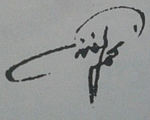Najm Afandi
This article needs additional citations for verification. (September 2016) |
Najm Afandi | |
|---|---|
 Najm-Afandi-Portrait | |
| Personal | |
| Born | Mirza Tajammul Hussain 1893[citation needed] Agra, India[citation needed] |
| Died | 1975 (82 years)[citation needed] Karachi, Pakistan[citation needed] |
| Resting place | Sakhi Hassan-GraveYard |
| Religion | Islam |
| Nationality | Indian, Pakistani |
| Ethnicity | Indian |
| Main interest(s) | Religious Poetry (Marsiya, Noha) |
| Notable work(s) | Noha: 'Aey Waey Nahre Alqama' 'Raaj dulara Zehra ka' Books: Kainat-e-Najm, Khosha e Anjum, Huan Najm, Rubaiyat Najam Afandi |
| Occupation | Poet, writer |
| Signature |  |
Najm Afandi (1893–1975) نجم آفندی was an Urdu poet in India.
Life[]
Najm Afandi was born in Agra, India in 1893. His father Bazm Afandi was also a poet.[1]
He moved to Hyderabad, Deccan.[citation needed] He started writing poetry early in his life and continued for 65 years.[citation needed]
His nazm durr-e-yateem was popular, which he wrote while he was only 15 or 16 years of age.[citation needed] He experimented with various genres of Urdu poetry.[citation needed] Najm had in the later part of his life dedicated himself to writing marsiya, salaam, manqabat and qasida.[citation needed]
Although he wrote numerous ghazals and nazms, because of the religious nature of his poetry and the issues he dealt with, he was known as 'Shair-e-Ahle-bait.'[citation needed]
Work and Career[]
Long before the Progressive Writers Movement came into existence his poetry dealt with the issues and themes which were the hallmark of the movement.[citation needed]
He published five collections of poetry; Mah-e-Wafa, Iqbal-e-Wafa, Jamal-e-Wafa, Ilham-e-Wafa, and he had noted the name of Najm Afandi and Haider Dehlvi as his teachers in each one of them.[citation needed]
He influenced generation of poets who adopted marsia, salam, qasida and other similar genres of poetry in Urdu.[citation needed]
Death[]
He died naturally in 1975 in Karachi and is buried at the infamous Sakhi Hassan Graveyard, North Nazimabad.[citation needed]
References[]
- ^ "COLUMN: The art of marsiya". www.dawn.com. 2 November 2014. Retrieved 24 October 2015.
External links[]
- 1893 births
- 1975 deaths
- Urdu-language poets
- Indian Muslims
- Indian male poets
- People from Agra
- 20th-century Indian poets
- Poets from Uttar Pradesh
- Muhajir people
- 20th-century Indian male writers
